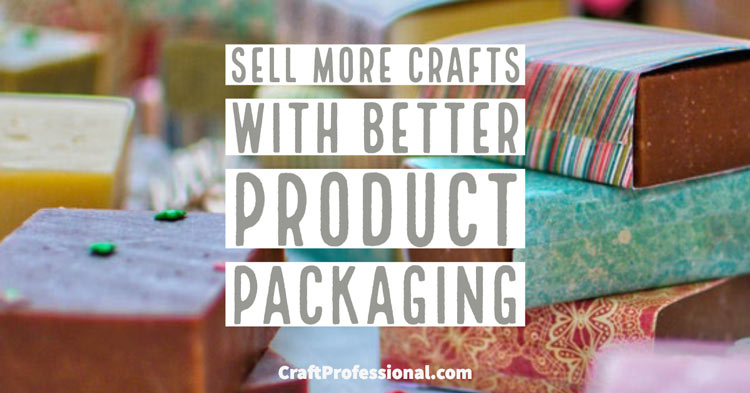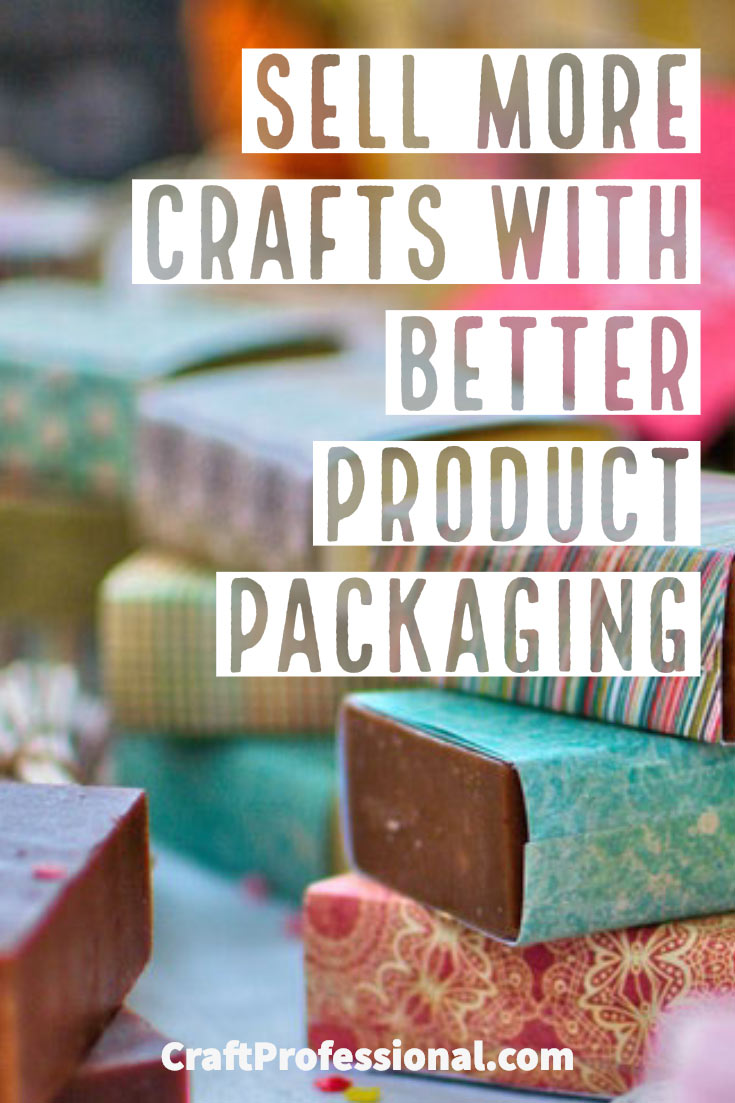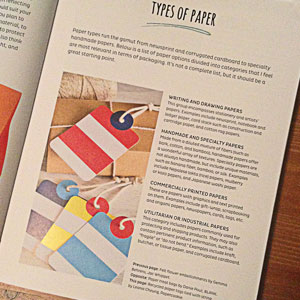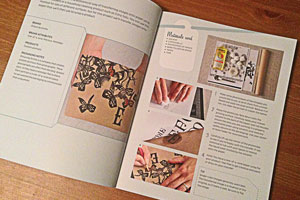Craft Packaging to Boost Profits
Sell more products at higher profit margins with great craft packaging.
The right craft packaging can not only help you sell more crafts, but also raise the perceived value of your products so you can sell them at a higher price.
We've all been charmed by fantastic packaging at some time.
You catch yourself bringing a bottle of soap up to the cash register because the container it comes in is just completely gorgeous. And you know it costs a little more than the soap that comes in a boring bottle, but you imagine that pretty bottle sitting on your counter, and you just don't care that you're spending a little extra.
I've done that more times than I'd like to admit. I'm pretty sure I'm not alone.

I earn a commission for purchases made through links on this page.
To learn more, please see my disclosure.
If we know gorgeous packaging can make us buy more, why not get the allure of attactive packaging working for you so your customers will buy more?
Fabulous Craft Packaging is Worth the Effort
Creating great packaging for your products is well-worth the extra time and expense it takes to create it.
Effective product packaging can improve profits by:
- helping you sell more products
- and improving the perceived value of your product, allowing you to sell items for a higher price.
Imagine being able to sell more of the same product you already create, and for more profit per item. How fantastic would that be?
Great packaging can help you accomplish that goal.
Beyond contributing to your brand image, great packaging is practical. It protects your products, so they arrive at customers' homes safely, saving you from negative feedback on your online shop. It also conveys important and necessary information about your products, ensuring customers have all of the information they need about the product they purchased.
Put Some Thought Into Your Craft Packaging

Packaging is important enough that it should be more than just an afterthought. Instead, think of your craft packaging as part of your product. Packaging can be integrated and included in the design and production of your work.
Way back in the days when I sold handmade jewelry at craft shows, I thought it was inefficient to spend much money or time on packaging. My approach was to create the packaging as quickly and as inexpensively as possible.
I didn't think of packaging as part of the whole product development and production process. I didn't consider it to be a part of my product marketing or the customer experience.
Unfortunately, that lack of care showed, and I'm willing to bet I lost sales because of it.
If you build packaging into your production process, you can create a cohesive, whole product with an increased perceived value. I'm certainly not saying you need to break the bank with pricey packaging or spend endless hours on creating it. You can create effective packaging for handmade items that's both inexpensive and efficient to assemble.
Remember, the point of putting a little extra effort into the packaging is to increase your profit, not to add loads of time to production or wildly increase the cost of raw materials used to create your products.
Consider spending a bit of time and money on your packaging up to the point that it increases your product's perceived value and increases your profit.
Find a Balance With the Cost and Time You Invest in Your Packaging
I don't have a precise formula to tell you exactly how much time and money you should spend on creating your product's packaging. You'll need to use your best judgment based on the type, number, and profit margin of the items you sell.
Look at the number of items you sell and the profit margin on each item:
- If you sell a lot of lower priced items with a smaller profit margin, you'll likely benefit most from using packaging that is attractive, but fairly inexpensive and quick to put together.
- If you sell a few higher priced items with a larger profit margin, you can benefit from adding more luxurious packaging that may take a little more money or time to put together.
Your packaging choices will also be influenced by your target market. Your packaging design must reflect the image you want to portray and the story you want to tell through your brand.
If you're selling luxury items, for example, your customers will expect and appreciate higher-end packaging. On the other hand, if you're selling eco-friendly products, your packaging should reflect those values.
Do Your Research
A little research will help you to determine how much room you have to increase your price with better packaging. Look for products that are similar to your own but already have great packaging and a higher-end feel to their overall brand.
Ask yourself:
- How much do their items sell for?
- Do you think you could sell your products for a similar price if you developed a higher end look for your packaging?
- Is there anything other than packaging that differentiates the product, allowing it to be sold at a higher price?
Some types of products and markets can sustain higher prices than others, so do be sure to do a little research to see what similar products with great packaging are selling for.
Product Packaging Practicalities
Of course, you need to look beyond appearance when developing your craft packaging. In addition to communicating your brand image and enticing customers to buy, your packaging also keeps your products safe and conveys important information.
Here are a few practical matters to consider while developing your packaging:
Will you be shipping your product?
If you're selling online and shipping products in the mail, your packaging will need to be designed to protect your product adequately and still look great so your customer will be thrilled when she receives it.
You may also want to consider how the packaging size and weight will affect your costs to ship. If using a slightly smaller box will be cheaper to ship and still keep your product safe, that's a simple way to keep expenses down for you and your customers.
Check with your local postal service to get information about how package size impacts shipping costs. Shipping costs can be a reason people don't buy, so it's wise to keep them down as much as possible.
Is your product fragile? Do you need to protect your products from temperature extremes or moisture?
It probably goes without saying, but do be sure to include protective wrapping if your products are fragile, particularly if you're shipping products in the mail. Similarly, if your products might be damaged by exposure to moisture, cold, or heat, be sure to take those concerns into account when you design your packaging.
Do you need to include product information on your packaging?
In addition to your company name and contact information, you may need extra information on your packaging. Flavors, scents, raw materials, quantities, sizes - you may need or want to include any of these details on your packaging. In fact, in many countries, there are laws requiring certain information to be included on product labels.
I'm not a lawyer by any stretch of the imagination, so I can't give you specific advice about information that's legally required on different types of products. If you need that information, I'd suggest contacting your local Small Business Administration (SBA) office in the US, or start at your local business development office or Chamber of Commerce in other countries. They'll be able to point you to the information you need.
Do you need multiple types of packaging or different labels?
If you make different sized items, you'll need to think through all of your packaging needs and create a unified look that works with all sizes of products you offer.
Similarly, if you make items that are the same size, but have different types (think scented candles, or handmade soaps), you'll need to find a way to indicate the type on your labels in a way that maintains a consistent look across your product line and isn't too complex, so your process remains as streamlined as possible.
Do customers need to touch or smell your products?
Make sure your packaging doesn't get in the way of customers experiencing your products. The more a customer can experience your product, the more you can encourage them to buy.
For example, don't let excessive packaging prevent customers from smelling your handmade soaps or candles. Be sure your packaging doesn't discourage customers from touching and trying things on because that kind of engagement with your product is what leads to sales.
How to Create Craft Packaging
Now that I have you convinced that great packaging can help make your business more profitable, provide a better experience for your customers, and protect your products, you're probably wondering how in the world you'll get started with creating your craft packaging.
When designing product packages and labels you need to think about:
- How the design fits with your brand and your target market's expectations
- The effect on your product's perceived value
- The cost your packaging will add to your raw materials vs. the potential increase in sales and profit margin created by the packaging
- The time it will take to assemble the packaging
- How your packaging will protect your product
- How your packaging and labels will communicate important information
- How your packaging might affect the ways customers interact with your product
What you need next are some practical ideas and resources for creating your own packaging and labels.
So where do you get ideas for creating this beautiful and functional craft packaging?
I'm glad you asked!
While researching great craft packaging, I found a lovely book called Packaging Your Crafts by Viola E. Sutanto. It's full of very attractive handmade product packaging ideas that are a good fit for crafts and can raise the perceived value of your items without adding too much time or cost to the production of your products.
The ideas in the book are completely achievable by the average craft business owner. That is, although they may require you to learn a few basic new skills, for the most part, the techniques are simple enough to learn quickly. Also, most of the ideas can be achieved with simple tools and reasonably priced materials.
The book has plenty of gorgeous examples, and it is divided into three useful sections:
- How to use different types of packaging materials including: paper, plastic, fabric, alternative materials, repurposed and upcycled materials
- How to package different types of crafts including: jewelry, ceramics and glass, food and plants, bath and beauty, clothes, shoes and accessories, soft furnishings, paper goods, home and living
- Resources
Here are a couple of packaging ideas for handmade items that I love from the book - one that's quick and easy, and one that's a bit more complex.
Easy DIY Hang Tags

These paper tags are pretty and would be great for dressing up your crafts easily and inexpensively. They'd fit perfectly in a nautical-themed display, but the design could be altered to suit a different look.
Although they are simple, there is attention to detail. It's clear they have been designed with care. The stripes are clearly nautical, the string brings to mind ropes used on ships, and the round reinforcement stickers add an extra level of detail and look like mini round life preservers.
These tags are simple enough to put together, but they would add some flair to your products. Product information could be hand written if you don't have a lot of products, or you could print stickers that fit neatly on the tags with your product information. You could assemble these hang tags while watching your favorite show, or you could recruit your family to do some simple assembly work.
Image Transfer Technique to Create Your Own Custom Boxes

This image transfer technique featured in Packaging Your Crafts is more involved, but the end result is gorgeous.
It would take a little practice to master the technique, and creating the packaging would also take more time. It's not the type of packaging design you'd want to use if you sell a lot of lower profit items. However, it does add a very special attention to detail that could be worthwhile for craft professionals who sell a smaller number or higher-end products with a higher profit margin.


New! Comments
Have your say about what you just read! Leave me a comment in the box below.